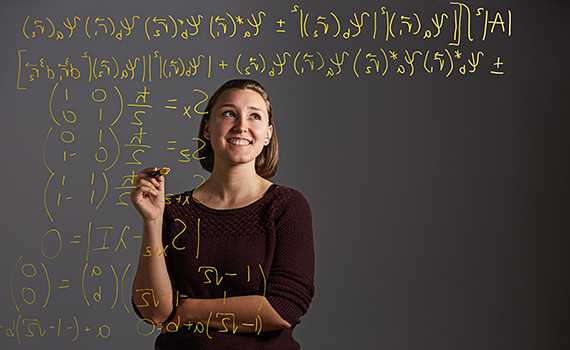From National Defense to Health Care Startup, Physics Major Finds Future Anywhere She Wants
By Kylie Gray
 Drexel physics student Riley Stanford
Drexel physics student Riley Stanford
April 3, 2018
The thrill of solving complex problems — and the countless applications of her degree — have drawn Drexel University physics junior Riley Stanford to bridge the disciplines of engineering, biophysics, chemistry, math and more, and to tackle challenges as wide ranging as threats to national defense and a mutant strain of Alzheimer’s disease.
Stanford’s first co-op was in the Weapons Control Systems department of aerospace and defense giant Lockheed Martin. The role — a systems engineering position — challenged her to write and fix code for a simulated threat to national defense using computational skills she learned in her physics courses.
“My biggest project at Lockheed took me two months to do; I had to find the problem and implement a fix in the code,” she says. "It was very much like untangling a pair of headphones you find in your pocket — you keep finding more and more problems — but it was very cool. The first day I got the fix working, I ran up and down the hall telling my cubemates. It left me feeling like I had learned something and made an impact at my co-op.”
Stanford was selected for a second systems engineering co-op at Lockheed her pre-junior year, this time in the Command and Decision department. For both positions, she had to pass federal security clearances and prove her coding abilities alongside computer science and engineering majors.
“The physics department prepares you during your first year to use coding in your co-op and then you can decide if you want to pursue software development or go more into research,” she says. “Once you understand the logic behind coding, you can keep picking up other languages. It’s super useful to gain that foundation.”
Stanford explored the research side of physics as a freshman, intrigued by a professor’s project on a mutant strain of Alzheimer’s disease found in Osaka, Japan. Under the direction of Brigita Urbanc, PhD, associate professor of physics, Stanford used computational modeling to simulate protein deletions caused by the disease in folds of the brain. She has continued the research part time alongside her co-ops and academics, and plans to make it the focus of her senior thesis. Although she does not plan on a career in physics research, the experience opened her eyes to the range of issues the field can address.
“I’ve always been more interested in the engineering and computer science aspects of physics,” she says. “I chose physics because I liked that you could have the jobs that a lot of those majors could have, but also pave your own path academically.”
This spring, Stanford’s diverse experiences will help her tackle a new set of problems in her third co-op at Lia Diagnostics, the company behind the first biodegradable, flushable pregnancy test. As Research and Development Manager, Stanford will rely on her interdisciplinary background as she helps bring the product to market. The Lia pregnancy test received FDA clearance in December and is scheduled for release this summer, promising a more sustainable alternative to traditional pregnancy tests.
“Since I will be working at a small startup, I anticipate wearing a lot of hats and filling in however I can. It’s completely different from my previous work, but I expect to learn a lot about business models and how startups get off the ground,” she says. “This is a dream co-op and I’m so glad that I got to make it happen!”
Stanford says the support she’s found in diverse communities — from her coworkers at Lockheed to peers in Drexel’s Women in Physics Society — has played a big role in her personal, professional and academic growth. She frequently attends office hours with professors and has formed close relationships with several of them, including Associate Professor of Physics Michelle Dolinski, PhD. Through Dolinski’s mentorship, Stanford has learned that asking for help is not a “weakness,” as she originally thought, but an important tool for academic success.
“Physics is something I need to work hard at to say afloat, but I think that makes me more employable and better at learning,” she says. “Because I’m willing to ask questions, I know what to ask to get to where I need to be.”
Stanford, who also has minors in math and mechanical engineering, is determined to pass on that constructive perspective as a tutor in the Academic Center for Engineers. She uses real-world experiences to illustrate mathematical concepts for students who struggle in physics, chemistry and engineering. When academic pressure becomes too much, Stanford suggests shaking things up with something totally different.
For her, that means roller derby, taking her third improv comedy course, and teaching body pump classes at the Drexel Recreation Center. Pushing out of her comfort zone — both academically and socially — has come to define her Drexel experience.
“One of my favorite things about Drexel is meeting people who are from somewhere else, doing something else, on a different part of their path than I am,” Stanford says. “I like that so many people come together in this city.”